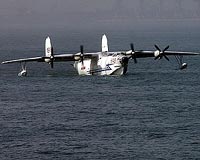 |
New York (UPI) Oct 29, 2009 Instrument maker Safe Flight has won a contract to supply its Powerline Detector to Enstrom 480B helicopters for the Thai army. The contract, awarded by Enstrom Helicopter Corp., means Safe Flight's unit will be sold to all other Enstrom 480 and 480B operators as a production option or as a retrofit. Safe Flight has applied to the FAA for a Supplemental Type Certificate for the Enstrom 480 and 480B. Enstrom has also taken delivery of a Powerline system for installation and developmental flight testing likely to start in the first quarter of 2010, Enstrom said in a statement. Safe Flight, based next to Westchester Airport in White Plains, N.Y., has said the physical dangers of high-tension electric power lines are constant but often undetected in some areas. Between 1997 and 2006 the U.S. Army recorded 54 so-called wire strikes in which 13 military personnel died and which caused $224 million in damages. Also in the same period there were 102 civilian wire strikes, killing 33 people, according to data from the National Transportation Safety Board. Safe Flight offers 50Hz and 60Hz versions of Powerline Detector. The version needed will depend on the location of the aircraft operations and the power source in that geographic area. Safe Flight and Enstrom will certify both systems allowing for global distribution. The Powerline Detection System is a small, lightweight system mounted on the pilot's instrument panel that shows a red warning light when the detector picks up the electromagnetic field from nearby power lines. There is also a warning sound sent out through the cockpit sound system and which sounds similar to a Geiger counter. The sound increases in volume the closer that the helicopter gets to the power lines. The system has been FAA and EASA certified and is operating around the globe, Safe Flight said. Unlike traditional wire cutters that are intended to cut power lines and add significant weight and structural requirements to an airframe, Safe Flight's PDS system weights less than 3 pounds installed and is designed to avoid contact altogether. The installation requirements are minimal and can be performed by any reputable avionics shop. Enstrom said its 480 and upgraded 480B light turbine helicopters are designed to go head to head with the Bell 206B Jet Ranger and MD500. FAA certification to FAR 27 standards was received in 1994, and the 480 has now been certified in 13 countries. More than 50 480B helicopters are now used for pilot instruction, law enforcement, power line and pipeline patrol, executive transport charter, electronic news gathering, and cargo and passenger services. The 480 turbine engine variant started life as the piston-engine TH-28 in response to the U.S. Army New Training Helicopter requirement. The TH-28 was further developed into the 480 for the civilian market and is powered by a Rolls-Royce/Allison 250-C20W turbine engine. Mission weight for the 480B at 3,000 pounds is 355 nautical miles at a maximum cruise speed of 109 knots (125mph). Other recent customers include the Indonesian police, which ordered 18 480Bs in 2003. A key feature of the 480B is that it has no hydraulic system, meaning maintenance is simplified, according to an Enstrom statement. Share This Article With Planet Earth
Related Links Aerospace News at SpaceMart.com
 China sets year for amphibious flight
China sets year for amphibious flightBeijing (UPI) Oct 22, 2009 The first flight of possibly the world's largest amphibious plane is set for 2013 with mass production to begin in 2015, according to Chinese media. The Chinese government announced in June that it would develop and produce the Dragon 600, similar in size to an Airbus A320 passenger plane. Aviation Industry Corp. of China was given the task of putting the project together, but no date ... read more |
|
| The content herein, unless otherwise known to be public domain, are Copyright 1995-2009 - SpaceDaily. AFP and UPI Wire Stories are copyright Agence France-Presse and United Press International. ESA Portal Reports are copyright European Space Agency. All NASA sourced material is public domain. Additional copyrights may apply in whole or part to other bona fide parties. Advertising does not imply endorsement,agreement or approval of any opinions, statements or information provided by SpaceDaily on any Web page published or hosted by SpaceDaily. Privacy Statement |